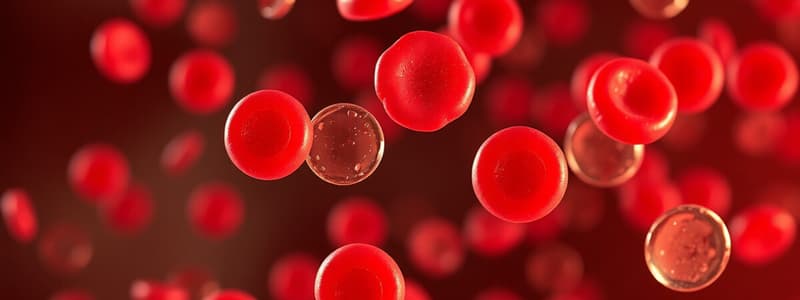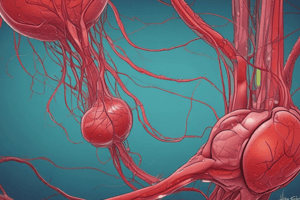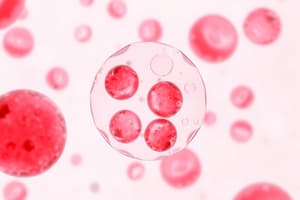Podcast
Questions and Answers
Which of the following is NOT a characteristic component of platelets?
Which of the following is NOT a characteristic component of platelets?
- Serotonin, which aids in local vasoconstriction
- Adenosine diphosphate, which promotes platelet aggregation
- Fibrinogen, which directly lyses clots (correct)
- Platelet factors (phospholipids), which assist in clotting
What is the primary role of von Willebrand factor (vWF) in platelet plug formation?
What is the primary role of von Willebrand factor (vWF) in platelet plug formation?
- To promote the adhesion of platelets to the lining of endothelial cells (correct)
- To inhibit the aggregation of platelets at the site of injury
- To activate the intrinsic clotting pathway
- To dissolve the formed platelet plug
What mechanism prevents the formation of a widespread platelet plug beyond the site of a damaged blood vessel?
What mechanism prevents the formation of a widespread platelet plug beyond the site of a damaged blood vessel?
- Synthesis and release of prostaglandin I (prostacyclin) and nitric oxide (NO) by undamaged endothelial cells (correct)
- Consumption of all available adenosine diphosphate (ADP)
- Activation of the extrinsic clotting pathway
- Secretion of thromboxane A2 by endothelial cells
How do citrates and oxalates function as anticoagulants?
How do citrates and oxalates function as anticoagulants?
Tissue plasminogen activator (tPA) is administered to patients experiencing thrombotic events. What is its function?
Tissue plasminogen activator (tPA) is administered to patients experiencing thrombotic events. What is its function?
Warfarin (Coumadin) is prescribed as an anticoagulant. What is its mechanism of action?
Warfarin (Coumadin) is prescribed as an anticoagulant. What is its mechanism of action?
Which of the following is the correct definition of an embolus?
Which of the following is the correct definition of an embolus?
What is the primary function of antithrombin?
What is the primary function of antithrombin?
Why are individuals who have recently undergone surgery at a higher risk for thromboembolic events?
Why are individuals who have recently undergone surgery at a higher risk for thromboembolic events?
An individual with blood type A will have which of the following?
An individual with blood type A will have which of the following?
How do damaged endothelial cells contribute to the initiation of platelet plug formation?
How do damaged endothelial cells contribute to the initiation of platelet plug formation?
What is the role of thromboxane A2 in platelet plug formation?
What is the role of thromboxane A2 in platelet plug formation?
How do endothelial cells of undamaged blood vessels prevent the spread of platelet aggregation?
How do endothelial cells of undamaged blood vessels prevent the spread of platelet aggregation?
Why is Vitamin K crucial for normal blood clotting?
Why is Vitamin K crucial for normal blood clotting?
How does the administration of E-amino caproic acid impact a hemophilic patient undergoing surgery?
How does the administration of E-amino caproic acid impact a hemophilic patient undergoing surgery?
What is the primary difference between a thrombus and an embolus?
What is the primary difference between a thrombus and an embolus?
Which of the following mechanisms contributes to vasoconstriction following vessel injury?
Which of the following mechanisms contributes to vasoconstriction following vessel injury?
How do citrates and oxalates prevent blood clotting?
How do citrates and oxalates prevent blood clotting?
If a patient has type B blood then which agglutinins will be present?
If a patient has type B blood then which agglutinins will be present?
Why are individuals with thromboembolic conditions often prescribed anticoagulants?
Why are individuals with thromboembolic conditions often prescribed anticoagulants?
Flashcards
Platelets
Platelets
Oval/spherical fragments, 3 microns in size. Roughly 250,000 per cubic mm of blood. Essential for clotting.
Thrombopoiesis
Thrombopoiesis
The process of platelet formation in red bone marrow via megakaryocytes.
Hemostasis
Hemostasis
A two-step process: 1) activation and aggregation of platelet plug. 2) Blood clotting
Platelet Plug Formation (Stage I)
Platelet Plug Formation (Stage I)
Signup and view all the flashcards
Chemical Mediators in Platelet Adhesion
Chemical Mediators in Platelet Adhesion
Signup and view all the flashcards
Inhibitors of Platelet Adhesion
Inhibitors of Platelet Adhesion
Signup and view all the flashcards
Thrombin
Thrombin
Signup and view all the flashcards
Inhibitors of Prothrombin Activation
Inhibitors of Prothrombin Activation
Signup and view all the flashcards
Hemophilia
Hemophilia
Signup and view all the flashcards
Fibrinolytic System
Fibrinolytic System
Signup and view all the flashcards
Megakaryocytes
Megakaryocytes
Signup and view all the flashcards
von Willebrand factor (vWF)
von Willebrand factor (vWF)
Signup and view all the flashcards
Vasoconstriction
Vasoconstriction
Signup and view all the flashcards
Embolus (emboli)
Embolus (emboli)
Signup and view all the flashcards
Embolism
Embolism
Signup and view all the flashcards
Serum
Serum
Signup and view all the flashcards
Agglutination
Agglutination
Signup and view all the flashcards
Antigens
Antigens
Signup and view all the flashcards
Antibodies
Antibodies
Signup and view all the flashcards
Study Notes
- Platelets are part of the formed elements of blood.
Platelet Physical Description
- Platelets are oval/spherical in shape
- They are 3 microns in size, smaller than red blood cells (7-8 microns)
- There are roughly 250,000 platelets per cubic mm of blood.
Thrombopoiesis and Platelet Formation
- Platelets are formed in red bone marrow
- They originate from large precursor cells called megakaryocytes
- Megakaryocytes undergo fragmentation, pinching off bits of cytoplasm to form platelets
- Platelets are considered fragments of cells rather than actual cells, hence the disuse of the term "thrombocytes."
Platelet Components
- Platelets contain many granules
- They have adenosine diphosphate, which promotes platelet aggregation
- Platelet factors (phospholipids) aid in clotting
- Serotonin brings local vasoconstriction
- Platelets contain actin and myosin
Platelet Function
- Platelets aid in hemostasis, a 2 step clotting process, involving activation/aggregation of platelet plug, then blood clotting
Platelet Plug Formation (Stage I)
- Vessel damage initiates the process by tearing endothelial cells of the inner lining, exposing collagen
- Collagen promotes formation of the von Willebrand factor (vWf)
- vWf is a plasma protein secreted by cells and platelets that promote platelet adhesion to endothelial cells
- Platelets adhere, activate, and aggregate, releasing substances that amplify the response
- Chemical mediators are released:
- Adenosine Diphosphate (ADP) stimulates more platelets to adhere via positive feedback
- Serotonin acts as a local vasoconstrictor
- Thromboxane A2 has a positive feedback effect on platelets and promotes platelet adhesion
- Chemical mediators lead to vascular smooth muscle contraction within damaged vessels, causing vasoconstriction
- A platelet plug forms with positive feedback promoting platelet adhesion
Regulatory Mechanisms
- The platelet plug forms only where the vessel is damaged, preventing clotting in nearby regions
- Endothelial cells of undamaged regions synthesize and release:
- Prostaglandin I (PGI, or Prostacyclin)
- Nitric Oxide (NO), a vasodilator
- PGI and NO inhibit platelet adhesion, activation, and aggregation
Blood Clotting
- Autocatalysis is involved, with thrombin as the main autocatalyst
- Vasoconstrictor action takes place through:
- Reflex vasoconstriction in the injury region
- Compression of the vessel via mass clotted blood (capillary adhesion)
- Release of vasoconstrictor principle via lysis of platelets (serotonin)
Prothrombin Activation Inhibitors
- Heparin is an intrinsic anticoagulant produced in small amounts in humans, and in large amounts in leeches
- Antithrombin is an intrinsic inhibitor
- Citrates and oxalates are used experimentally, as they chelate calcium and inhibit clotting, since calcium is an important cofactor
- Rhubarb leaves are filled with oxalates and thus humans can only eat the stalks
Clotting Disorders
- Hemophilia is a sex-linked recessive trait on the X chromosome
- The underlying issue of Hemophilia is a deficiency in Factor VIII or others, affecting correct messenger production
- Females are generally not affected by hemophilia
Fibrinolytic System
- Plasminogen (profibrinolysin) converts to plasmin (fibrinolysin), leading to clot lysis
- Tissue plasminogen activator (TPA) is secreted by endothelial cells to convert plasminogen into plasmin
- Plasma activators, such as urokinase from kidney cells, activate it
- Some bacteria produce streptokinase which can lyse clots exogenously
- Doctors may inject antifibrinolytic drugs like E-amino caproic acid to prevent the activation of plasminogen into plasmin in hemophiliac surgery patients
Terminology
- Coumadin (Warfarin) antagonizes Vitamin K, having a depressant effect on clotting factor production and is given to people vulnerable to clot formations
- Thrombus (thrombi) is a clot formed in a blood vessel, possibly from atherosclerosis
- Embolus (emboli) is a detached clot freely floating in a blood vessel
- Embolism is the occlusion of a vessel by a transported clot
- Thromboembolic condition is caused by:
- Artery narrowing from atherosclerosis, plaque, infection, or trauma
- Roughened interior activating the intrinsic clotting pathway
- People who have recently had surgery have a higher predisposition to a thromboembolic event
- Normal clotting time is 2-3 minutes, but can last up to 6 minutes
- Serum is the portion of blood after clot, blood cell, and platelet removal, it's plasma without clotting factors
Antigen-Antibody Reactions
- Agglutination is the clumping of donor and recipient red blood cells, often followed by hemolysis
- Antigens:
- Are substances that induce antibody synthesis
- Found on the surface of red blood cells
- Synonymous with agglutinogens
- An individual is born with these
- They determine an individual's blood type
- Antibodies:
- Are protein substances that combine with a certain antigen
- Found in the plasma
- Synonymous with agglutinins
- These are not present at birth and develop over time
ABO Blood Groups
- Blood types are named for agglutinogens present on RBC membranes
- Type A (41%) has Agglutinogen A, and Agglutinin Anti B
- Type B (10%) has Agglutinogen B, and Agglutinin Anti A
- Type AB (4%) is the universal recipient, has Agglutinogen A,B, and no Agglutinin
- Type O (45%) is the universal donor, has no Agglutinogen, and Agglutinin Anti A, Anti B
Rh Blood Group
- The Rh factor is inherited from the Rhesus Monkey
- Rh+ has the D agglutinogen in the RBC membrane (85%)
- Rh- has no factor (15%) and no agglutinins in the plasma
Studying That Suits You
Use AI to generate personalized quizzes and flashcards to suit your learning preferences.




